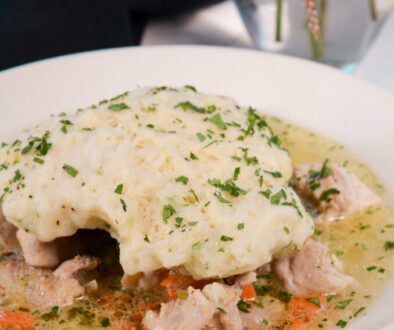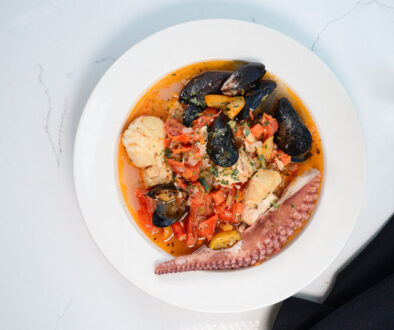Rea’s Legacy
For five generations, Rea’s farm has been an integral part of the Cape May peninsula. In 1922, George Rea and his wife, Mary, purchased 95 acres for a dairy farm, known as the “propeller dairy”—named for a mysterious plane that had crashed on the property. When George passed away, the youngest son of his four children, Leslie Hyatt, took over, and continued to farm and raise and sell Black Angus cattle and racehorses. Leslie Hyatt and Amy Carlson raised Leslie Charles and Ernie in the historic Whilldin-Eldredge house, one of the oldest in the county, built prior to 1730. When Leslie Hyatt passed away, Leslie Charles purchased the family farm and business outright.
In 1940 Leslie Hyatt farmed 15 acres of lima beans. Ten years later, the lima bean crop expanded to a thousand acres on rented land and was sold to commercial businesses. Soon, farmers were growing 2000 acres, and the county became known as the “Lima Bean Capital of the World.”




In 1960 Leslie married Diane Davis, a schoolteacher. Diane was one of the first women to graduate from Trenton State College. With her Industrial Arts degree, believing strongly that there should be more women who choose this career, she went on to teach General Shop and Drawing at Deptford Township School. Leslie and Diane had two daughters, Jeannette and Carol.
In 1996, the lima bean business was going the way of imports, as one commercial wholesaler after another canceled their contracts. To add more strife for the Rea’s, dry seasons and record-breaking heat caused crop loss, coupled with an increase in supply and gasoline, and the future of the farm looked grim. Faced with the reality that it could be lost to developers, in 1999, Leslie and Diane placed the property under the Farmland Preservation Program. They continued to farm their land but sold their development easements, meaning that the family still owned their land but sold the rights to develop anything other than agriculture. The deed will remain in effect for any future owners.
The remnants of the lima bean business are on Stevens Street where the “Beanery” was once a busy place. The faded brick-red structure sits high above the ground, reminiscent of an old, covered bridge, keeping the area dry. It once covered the thrashing machine, which was used to remove the lima bean from the pod. The beans cascaded down a ramp, straight into waiting boxes. The fresh beans were whisked away by trucks to the processing plant.
Lima bean production continues from Peru, making up close to 90% of the imported bean. But if you want to buy wholesome, natural lima beans, look no further. Today, Rea’s dedicates ten acres to Fordhook and pole lima beans, with production up to near 1940’s levels.
After joining the Farmland Preservation Program, the Rea’s also made an agreement with the New Jersey Audubon Society to lease birding rights to the property. The Rea’s plant sorghum, shrubs, and flowers as habitats for the birds. Audubon members purchase a pass for a nominal fee, allowing them full access to the farm. They meet at the Beanery, and the family only asks that visitors respect the land and fields and walk the crops’ perimeter. Diane recalled a fellow who was among a group of birders that had spotted a rare species of bird. He suddenly broke away from the group and ran between the rows of lima beans, literally bounding over each row of bushes, and never once touched a plant. She said, “It was the funniest thing I ever saw. Although there are rules about walking on the crop rows, I just couldn’t be mad at him because he hadn’t disturbed one leaf.”
At present, they farm 50 acres, while the remaining land is dedicated to wetlands, fallow fields, and woods. Rea’s Farm Stand began in 1996, after they moved an 8’x10’ building to the front yard of the farm. It was a modest construction with an open design, later expanded to what it is today. Diane, now 86 years old, continues to run the farm stand.

When Jeannette and Carol were children, they tended gardens, fed the livestock, and were active in the 4-H program, as their parents and grandparents previously were. Leslie worked long hours, getting up before dawn and was home by dinnertime. Carol recalls, “Oftentimes Dad would be at the dinner table and fall right to sleep!” Even at that young age, Carol understood that farming wasn’t an easy profession, yet the joy on her face as we toured and discussed the farm emphasized that she wouldn’t have it any other way.
As the girls grew older, Jeannette and Carol attended college, Jeannette earning a master’s in Agricultural and Extension Education at Ohio State, later becoming a 4H agent for the Youth Development program at Rutgers University. Carol earned a BS in mechanical engineering from Drexel University and a master’s in chemical engineering from Rowan University. She works full time at Corning Glass. Pharmaceutical technology is just one of her fields of expertise, and she often gets up earlier than the sun for overseas calls.
In 2021 Jeannette passed away, followed by the patriarch, Leslie, in 2022. It’s now up to the Rea women to continue the legacy. Diane and Carol (now Rea Flynn) plan to keep their legacy alive and continue the Rea family farm. Even Kaitlyn, Carol’s teenage daughter, is active in the farm and 4H community, like her mother, grandmother, and grandfather. Kaitlyn raises pigs and sheep to be entered in the 4H competition and raises chicks in her mother’s garage. Tyler, Carol’s son, is 22 years old and in the Navy, but when home, he works on the farm. Kelly Patrick Keppel, Carol’s fiancé, works full-time as an engineer, yet is dedicated to the farm, often working alongside Carol.
When I visited Rea’s in early spring (and again in the summer) Carol was on a tractor, tilling a field that hadn’t been used in eight years, and Kelly on another. They were readying the ground for pumpkin planting—the crop will be ready in late September, just in time for their Harvest Festival. She hopped off the tractor to give me a tour of the farm as Kelly continued plowing.



We walked the circumference of a pond. Carol said, “My grandfather created this quarter-mile dirt track solely for the purpose of racing sulkies. It was more of a hobby for him.” Some land in West Cape May was used in the late 19th to early 20th centuries for horse racing, and evidence remains on the farm today.
Carol explained agricultural terminologies, like plow, disk, and perfecta, to describe the tasks accomplished by the farming implements. Plowing breaks up the ground. This prepares the land for the next phase—disking, which chops up any large chunks, then the perfecta, a field cultivator, that fluffs up the soil. This readies the fields with the least amount of disruption to the soil, rarely going deeper than a foot. Their rototiller is used solely for pole lima beans and small spaces. Rea’s focuses on what can and cannot be planted successfully, based on the temperate weather, sandy loam soil, and natural nutrients. To avoid any rare nighttime freezing temperatures, they go full steam ahead beginning May 15, planting and harvesting, until October.
Rea’s is a self-contained farm, meaning they produce most of the food on their land with limited external help. The family prefers to not alter the ground with additives but uses crop rotation or plant cover crops instead, so as not to deplete the essential nutrients. They allow selected acres to “rest,” sometimes for years, before being put back to use. They drip irrigate and add soil, but never take away. Being located along the sea not only provides organic material but also a balmy salt air that nourishes the crops.
A large patch of strawberries had flowered on plants from last year’s crop; they are destined for use in homemade jams. In another field, newly planted strawberries had already taken root and were thriving—in mid-April, the fresh-picked fruit to be sold at the farm stand. We entered the “high tunnel” which is a huge, covered hoop that extends their growing season in the spring and fall. As Carol opened the door the humid 90+ heat blasted us. Infant tomato, squash, pumpkin, and other seedlings reared their tiny heads towards us. Drip irrigation hoses snaked along the plants, delivering water directly to the roots.
On another stretch of land next to a corn field were blackberry bushes. I asked how they deter the local bird population from devouring their crop. Other farmers choose netting, often ensnaring wildlife. Carol said, “It hasn’t really been a problem. Oh, the birds eat some here and there, but they get their fill and go along their way.” Seemed fitting that a natural wildlife refuge and a working farm could coexist as one.
Rea’s Farm grows lettuce, peppers, cantaloupes, tomatoes, green and yellow squash, lima beans and more. The fruits and vegetables that are successful continue to be planted each year, but Carol isn’t shy about trying new things and expanded the herb garden this year. Last fall, a local beer maker bought their pumpkins for a pumpkin beer. This year he made a summer ale using Rea’s dill and cucumbers.




Slowly and methodically, long abandoned farm equipment and storage buildings are being repurposed. The empty corncrib transformed into a chicken coop, with an old building attached for the hens who produce eggs in mid-summer.
Visions from the younger generation on how to streamline the farming process are apparent here. Recently they applied for a REAP grant (Rural Energy for America Program) to assist with installation of solar panels on a building. This will generate enough power to run all the electricity for the farm, from store refrigerators to the commercial kitchen, to running the main agricultural well used to water the crops.
Rea’s plays an integral part in the farming community as several local farmers use their land and other resources to grow and manage their crops such as corn, honey, and mushrooms and sell the produce and honey at the farm stand.
Rea’s has always played an active part in the local community, with Cape May City renting wagons from them each year to haul bands in the annual parades. In the fall, the family plans to cut a path through the corn stalks for a corn maze. There will also be hayrides. Rea’s attends local festivals throughout the year including the Strawberry Festival in June, the Tomato Festival in September, and naturally the Lima Bean festival in October. During the summer they participate weekly in the West Cape May Farmers Market, often with Kaitlyn at the helm, tending to the produce sales.
They are the founding members of the Cape May County Beach Plum Association. Four acres are slated for 300 beach plum bushes. When harvesting the beach plums, the Rea’s prefer to hand pick the fruit, while other businesses use machinery that shakes the bushes. It’s labor intensive, but the machinery method loses time by requiring the weeding out of sticks, leaves, and debris, and bruising the fruit.
They use the beach plums and strawberries in their jams and jellies and pies that are produced on the premises in their commercial Green Farmhouse Kitchen. Fresh-baked bread contains herbs and fruit grown on the farm. Farm produced fruit, like pumpkin, berries, along with supplementing fruit like apples and peaches, with the exclusive “Jersey Fresh” label are used in their pies. The ladies cook and can and bake pies and bread without air conditioning in the kitchen of the centuries-old house. During the hot summer, baking is done at night.
For 25 years, the “pie lady,” Norma Cruz, a retired French/Spanish teacher, has been making the pies for Rea’s. Her recipe has never been altered, using only butter in the crust. For over a decade, Teri Hislop, a tribal member of the Lenape Nation of Pennsylvania has cooked and canned the jams and jellies. The very land that is Rea’s Farm is on Lenapehoking, the ancestral land of the Lenape people.
Diane dumped out a jar containing arrowheads, tools, and more from the Lenape tribe, explaining, “Leslie was always bringing home rocks and treasures such as these that he’d uncover as he farmed the land.”
During the first full moon in August, the Lenape Nation Green Corn Festival is held on Rea’s Farm. At the public program, the Lenape tribe performs their native dances and traditions in the center of a circle of straw bales. They sell merchandise that remains true to the Lenape tradition. Then the tribe will hold their private meetings and camp overnight.
When it’s harvest time there’s no need to hire a crew. They just put the word out to their friends, neighbors, and any volunteers to lend a hand. Folks that work on the farm also chip in, bringing along their friends. When others need help, the Rea family pays back by making themselves available.
Rea’s features you-pick flowers based on the season—sunflowers, zinnias, gladiolas and more. They also support a local sheep farmer by selling his products.
Recently, Rea’s farm was honored with the prestigious Century Farm Award from the New Jersey Agricultural Society. This award is presented to a New Jersey farm that has been in the same family and has been in operation for 100 years or more.



Lima bean thrashing machines managed by Seabrook beginning in 1942. Amy and her little lamb in the backyard of the Whildian-Eldredge house.
Determination and dedication are powerful motivators when you bear the responsibility of continuing your family legacy. The Rea women have proven that women are unstoppable. They convey a powerful message to Kaitlyn and their descendants. They understand the importance of land preservation as farms throughout New Jersey and other states relinquish America’s land to developers paving over our precious resources.
From embracing local young entrepreneurs, Carol and her partner, Kelly, along with her mother Diane, are always looking towards the future and how their support will help local small businesses and keep themselves viable and productive at the same time. They lead by example for future generations demonstrating that farming cannot merely survive but thrive in a challenging industrialized society. The Rea family will always be a part of the South Jersey farming community and deserve a thank you from future generations.



